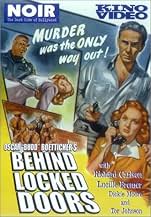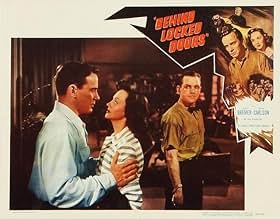अपनी भाषा में प्लॉट जोड़ेंA well-known judge has become a fugitive from the police, with a large reward on his head. A reporter believes that the judge is hiding in a private sanitarium, so she seeks out a private in... सभी पढ़ेंA well-known judge has become a fugitive from the police, with a large reward on his head. A reporter believes that the judge is hiding in a private sanitarium, so she seeks out a private investigator and asks him to pretend to be insane, so that he can get inside the sanitarium ... सभी पढ़ेंA well-known judge has become a fugitive from the police, with a large reward on his head. A reporter believes that the judge is hiding in a private sanitarium, so she seeks out a private investigator and asks him to pretend to be insane, so that he can get inside the sanitarium and look for the judge. The investigator is admitted to the asylum, and encounters many da... सभी पढ़ें
- Dr. Clifford Porter
- (as Tom Brown Henry)
- Mr. Purvis - a Patient
- (बिना क्रेडिट के)
- Mr. Topper - a Patient
- (बिना क्रेडिट के)
- Nurse
- (बिना क्रेडिट के)
- Dr. J.R. Bell
- (बिना क्रेडिट के)
- Trooper Captain
- (बिना क्रेडिट के)
- 'The Champ' - a Patient
- (बिना क्रेडिट के)
- Jim
- (बिना क्रेडिट के)
- Maintenance Man
- (बिना क्रेडिट के)
फ़ीचर्ड समीक्षाएं
They play man and wife, and she has him committed. Once inside, Stewart discovers that the place is run somewhat inhumanely, and that the judge may be in a ward of the asylum that is locked and inaccessible to other patients.
This is a B movie all the way with decent performances by Carlson and Bremer, Douglas Fowley and Tor Johnson and good direction by Budd Boetticher. I sort of hoped that, although the Bremer character was on the trail of the judge, that she might have been interested in some of the bad conditions at the asylum and wanted to expose them. Though things don't stay as they are there, it would have been nice if earlier, she had mentioned having any interest in it. Guess she just wanted the big story.
Good but not exceptional.
It seems like everything done in black and white in the forties, unless there was some singing and dancing in it, is now a film noir. (Well, excluding Olivier's 1949 Hamlet, I suppose.) When this "Poverty Row" production came out in 1948 I'm sure it was billed as a mystery/suspense tale, but never mind. "Film noir" is now a growth industry.
There's a gumshoe, Ross Stewart played by Richard Carlson, whom I recall most indelibly as Herbert A. Philbrick of TV's cold war espionage series "I Led Three Lives" from the fifties when HUAC had us all looking under our beds for commies. Lucille Bremer, near the end (which was also near the beginning) of a very modest filmland career, co-stars as Kathy Lawrence, a newspaper woman with a story idea. She needs a private eye to do the investigative dirty work.
Ross Stewart has just hung out his gumshoe shingle and had the frosted glass door of his office lettered and is paying the painter when Kathy Lawrence shows up. (I love all the private eye movies which begin with the dame showing up at the PI's office needing help. So logical, so correct; so like a noir "Once upon a time.") She wants him to pretend to be insane so that she can get him committed to a private sanitarium where she believes a corrupted judge is hiding, thus the locked doors in the title.
What I liked about this is the way the low-budget production meshed with the gloomy and aptly named "La Siesta Sanitarium," the scenes shot in rather dim light giving everything a kind of shady appearance. The story itself and the direction by Oscar "Budd" Boetticher defines "pedestrian," but there is a curious and authentic period piece feel to the movie that can't be faked. Postmodern directors wanting to capture late-forties, early fifties L.A. atmosphere would do well to take a look at this tidy 62-minute production.
Tor Johnson, the original "hulk" (perhaps) plays a dim-witted but violent punch drunk ex-fighter who is locked in a padded cell. He comes to life when the fire extinguisher outside his door is sadistically "rung" by one of the attendants with his keys, thereby springing the hulk into shadow boxing imaginary opponents. Could it be that he will get a live one later on...?
See this for Richard Carlson who made a fine living half a century ago playing the lead or supporting roles in a slew of low budget mystery, horror and sci fi pictures, most notably perhaps The Creature from the Black Lagoon (1954).
Richard Carlson, the detective, was a competent actor, but if somebody gave an award for the blandest leading man of all time, he would be in the running. Lucille Bremer, the beautiful reporter, was indeed beautiful, but she was undoubtedly at her best as a dancer (she could keep up with Fred Astaire!). As an actress, her talents were suspect. She is not even at her best in Behind Locked Doors. Since she was set to marry a millionaire and retire from the screen, it is likely that this, her last picture, was just fulfilling a contract obligation. It shows in her unenthusiastic performance. The obligatory romance between her and Carlson is sort of like a cigarette lighter with a used-up flint -- no spark. Lucille is more convincing when she's resisting his advances in the early going than when eliciting them in the later reels.
No Matter. This is an action, suspense picture, and their is plenty of both. Solid support to prop up the flaccid leads is provided by Thomas Browne Henry as the troubled doctor in charge of the institution, Douglas Fowley as a sadistic warder, and the always interesting (in a bizarre way) Tor Johnson as a homicidal maniac. Shadowy cinematography by Guy Roe heightens the sinister mood of the story and no doubt at the same time covers up cheap sets. Boetticher's sharp direction keeps the pace snappy and the suspense taut with nary a wasted shot in this little 63 minute programmer.
Take a gander at the poster pitching Behind Locked Doors. Beautiful Miss Bremer is pictured apparently swooned and lying limp and seductive while being carried by menacing hulk Tor Johnson. Nothing of the sort happens in this picture! Hollywood didn't invent the art of deceptive advertising -- surely it goes back at least as far as the early Roman Empire -- but the movie studios of Old Hollywood were certainly among its top exponents. Lurid and often sexy "promo shots" bearing little or no relation to the actual content of the picture were standard fare for movie posters of the era.
Nevertheless, much does happen in a short time in Behind Locked Doors, much of it lurid, though none sexy -- except perhaps for those of the persuasion that gets a kick out of seeing a woman tied up. If you're looking for a short, filler type of movie, this well-made thriller will keep your attention for and hour and three minutes.
The story opens with a reporter visiting the office of an inexperienced private investigator (Richard Carlson), with a proposition. The reporter believes that she knows where to find a prominent judge who has become a fugitive from the police (and for whom there is a $10,000 reward). She thinks that the judge is hiding in a private sanitarium, and wants the investigator to pretend to be insane so that he can get inside and find out. Most of the story that follows takes place inside the asylum, as the investigator tries to find the judge and stay out of danger.
The asylum setting is done well, and furnishes a suitable atmosphere. They use the setting in several ways to further the action, most notably with horror-film favorite Tor Johnson appearing as a dangerous inmate, along with a number of other strange inhabitants. The unusual setting adds considerably to the more routine aspects of the film.
"Human Gorilla" (also called "Behind Locked Doors") works rather well, and this is not a bad movie to check out if you like film noir or crime movies, and wouldn't mind the generally low production values.
क्या आपको पता है
- ट्रिवियाFinal film of Lucille Bremer.
- भाव
Ross Stewart: Kathy, you're my first client. Shall we celebrate by my carrying you across the threshold?
Kathy Lawrence: Oh, it's such a nice day, I think I'll walk.
- कनेक्शनReferenced in Budd Boetticher: A Man Can Do That (2005)
टॉप पसंद
विवरण
- चलने की अवधि1 घंटा 2 मिनट
- रंग
- पक्ष अनुपात
- 1.37 : 1
इस पेज में योगदान दें































